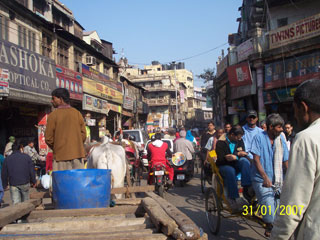
F For some reason, well-meaning Delhi-ites always try to dissuade you from visiting Chandni Chowk. I don't think it is because they are ashamed of this old, crowded part of Delhi. Rather, they only see the logistical hassles involved. It is like New Yorkers dissuading tourists from driving to the Hamptons on Friday evening. You know it will be great once you get there, but you also know what a hassle it will be to get there. For the record, Chandni Chowk is a must-see. Don't listen to the concierges, tour guides, friends, and well-wishers who tell you to "postpone it to the next trip when you have more time." That said, there is a way to do Chandni Chowk. Leave early—but not too early, or the shops won't be open. The spanking new Delhi Metro will whiz you over to the area in a few minutes from Connaught Place in Central Delhi, if you go before 10 a.m. The same trip an hour later would take an hour. I got off the Metro near Red Fort. No car will enter Chandni Chowk unless it belongs there. The lanes are too narrow. My driver fixed a rickshaw for me (like a tuk-tuk and just as wobbly) for a grand sum of $1.50. I ended up tipping the man almost double, mostly because he didn't ask for a tip. And then I sat back, got my camera out, and prayed. The streets are very narrow, and rickshaws, countless pedestrians, and cows all jostle to get through. There is an informal clicking noise that the wallahs (drivers) make with their tongue. It signals their impatience with the stalled traffic and works as well as a horn. But I forgot all this at the wondrous sights around me. In Chandni Chowk, I saw the Delhi that I had read about in history books. The Delhi unvarnished by the modernity that India is racing to embrace.

